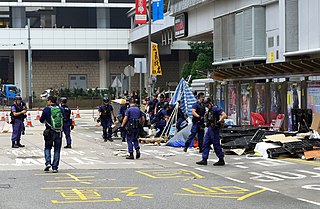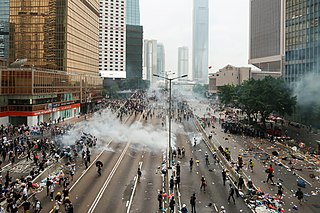
The 1981 Brixton riot, or Brixton uprising, was a confrontation between the Metropolitan Police and protesters in Brixton, South London, England, between 10 and 12 April 1981. The main riot on 11 April, dubbed "Bloody Saturday" by Time magazine, resulted in 279 injuries to police and 45 injuries to members of the public; over a hundred vehicles were burned, including 56 police vehicles; almost 150 buildings were damaged, with thirty burned. There were 82 arrests. Reports suggested that up to 5,000 people were involved.

The Hong Kong 1967 riots were large-scale riots between pro-communists and their sympathisers, and the Hong Kong government.
The Royal Hong Kong Regiment , formed in May 1854, was a local auxiliary militia force funded and administered by the colonial Government of Hong Kong.
The Toxteth riots of July 1981 were a civil disturbance in Toxteth, inner-city Liverpool, which arose in part from long-standing tensions between the local police and the black community. They followed the Brixton riots earlier that year.
The Hong Kong 1966 Riots was a series of disturbances that took place over three nights on the streets of Kowloon, Hong Kong in the spring of 1966. The riots started as peaceful demonstrations against the British colonial government's decision to increase the fare of Star Ferry foot-passenger harbour crossing by 25 percent.

In September 2009, Ürümqi, the capital of the Xinjiang Uyghur Autonomous Region in the People's Republic of China, experienced a period of unrest in the aftermath of the July 2009 Ürümqi riots. Late August and early September saw a series of syringe attacks on civilians. In response to the attacks, thousands of residents held protests for several days, resulting in the deaths of five people. In addition, the arrest and beating of several Hong Kong journalists during the protests attracted international attention.

In early August 2011, England was struck by riots, the worst in the country in decades. The timeline of the events of the riots spanned from 6–10 August.

The King assassination riots, also known as the Holy Week Uprising, was a wave of civil disturbance which swept the United States following the assassination of Martin Luther King Jr. on April 4, 1968. It was the greatest wave of social unrest the United States had experienced since the Civil War. Some of the biggest riots took place in Washington, D.C., Baltimore, Chicago, and Kansas City.

A series of sit-in street protests, often called the Umbrella Revolution (雨傘革命) and sometimes used interchangeably with Umbrella Movement (雨傘運動), or Occupy Movement (佔領行動), occurred in Hong Kong from 26 September to 15 December 2014.

Civil unrest occurred in Mong Kok, Hong Kong from the night of 8 February 2016 until the following morning. The incident escalated from the government's crackdown on unlicensed street hawkers during the Chinese New Year holidays. Eventual violent clashes broke out between police and protesters, resulting in injuries on both sides.

The Special Tactical Squad is a paramilitary task force of the Hong Kong Police Force, being a sub-division of the Police Tactical Unit (PTU). It was created in June 2014 to handle protests with its main tasks being crowd control and riot control, including when the PTU suffered from heavy blockade or obstruction. Examples were obstacle removal, conducting arrests, providing first aid, etc. The STS would also conduct observational and command related tasks, to ensure and review the Police Tactical Unit's use of force and tactics are appropriate, to further improve from past events. A report by Amnesty International singled out the Special Tactical Squad and riot police for "the worst abuses" of excessive force during the 2019 protests, noting that "almost every arrested person interviewed described being beaten with batons and fists during the arrest, even when they were not resisting and often already restrained," along with multiple hospitalizations.

The 2019 Hong Kong protests are ongoing series of demonstrations in Hong Kong triggered by the introduction of the Fugitive Offenders amendment bill by the Hong Kong government. If enacted, the bill would have allowed the extradition of criminal fugitives who are wanted in territories with which Hong Kong does not currently have extradition agreements, including Taiwan and mainland China. This led to concerns that the bill would subject Hong Kong residents and visitors to the jurisdiction and legal system of mainland China, thereby undermining the region's autonomy and Hong Kong people's civil liberties. As the protests progressed, the protesters laid out five key demands, namely the withdrawal of the bill, investigation into alleged police brutality and misconduct, the release of arrested protesters, a complete retraction of the official characterisation of the protests as "riots", and Chief Executive Carrie Lam's resignation along with the introduction of universal suffrage for election of the Legislative Council and the Chief Executive.

Intense confrontation between anti-extradition bill protesters and the Hong Kong Police Force occurred on 12 June 2019 outside the Government Headquarters in Admiralty, Hong Kong Island. The protest was sparked by the government's introduction of the controversial Fugitive Offenders amendment bill, which was set to go through second reading on 12 June despite mass opposition.









